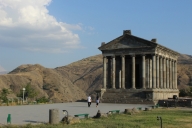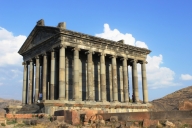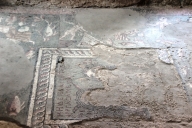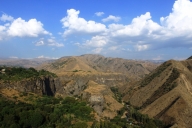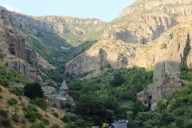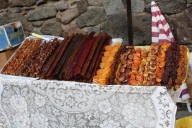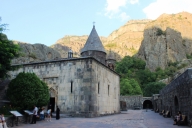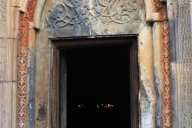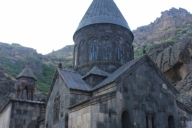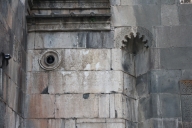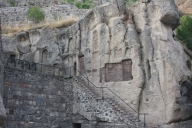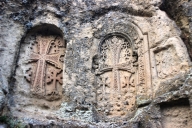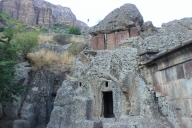UNESCO World Heritage Site inscription details
Visited in August 2013
Our take on it – A terrific site and a must see for any trip to Armenia.
A great way to start your tour of this beautiful Armenian site is at the nearby village called Garni, a place that has been inhabited since the 3rd millennium BC and used as a summer residence by the Armenian royal dynasty since the 3rd century BC.
The big draw of Garni is the Hellenistic temple dating back to the 1st century BC, which was destroyed by an earthquake and restored in the 1960s from original materials.
Next to the temple are the remains for a royal bathhouse, which are also worth a quick look, although there is not much left except the floor mosaics.
The Garni temple is located at the top of the Azat river gorge and while we did not have time to explore, the gorge is reputedly quite beautiful with the rocks on the sides of the riverbed sometimes called a “Symphony of Stone”.
Less than 11 kilometers away, Geghard is a walled monastery. Its fortifications were built after numerous attacks by Arab and Persian invaders.There is a small climb to the monastery gates from the parking lot, where local women often sell fruit sujukh ( a dessert of made of jellied fruit juice and walnuts, similar to Georgian churchkhela and definitely worth stocking up on) and gata – delicious sweet holiday bread.
Geghard reputedly dates back to the 4th century, founded by Gregory the Illuminator, the man responsible for Armenia becoming the world’s first Christian state. Originally it was called Ayrivank, for monastery of the cave, as the first monastery site was in a cave with a flowing spring. It’s current full name is Geghardavank for “Monastery of the Spear”. Allegedly, the spear that had been used to wound Jesus in the crucifixion was stored here along with a fragment of Noah’s Arc. The spear is currently on display at the Etchmiatsin treasury.
The main church was built in the early 13th century and its attached vestry is partly free-standing and partly carved into the cliff. In addition to the main chapel, there are several rock-hewn churches near the vestry, similar to the rock-hewn churches of Ethiopia, if not quite as spectacular from the outside.
There is very little light inside the buildings of Geghard, so hard to take pictures. Take our word for it, though – it is incredible to imagine all the daily activities in these walls over the centuries and it helps that there are very few tourists here, compared to the more well known medieval sites in Europe. Also, the acoustics in the rock-hewn churches of Geghard are great and with luck, you may be able to catch the church choirs singing in these walls. If not, here is a sample.
Be sure to take a look at the caves and khachkars in the rocks surrounding the monastery, as well as rooms in the fortification walls of the complex.


